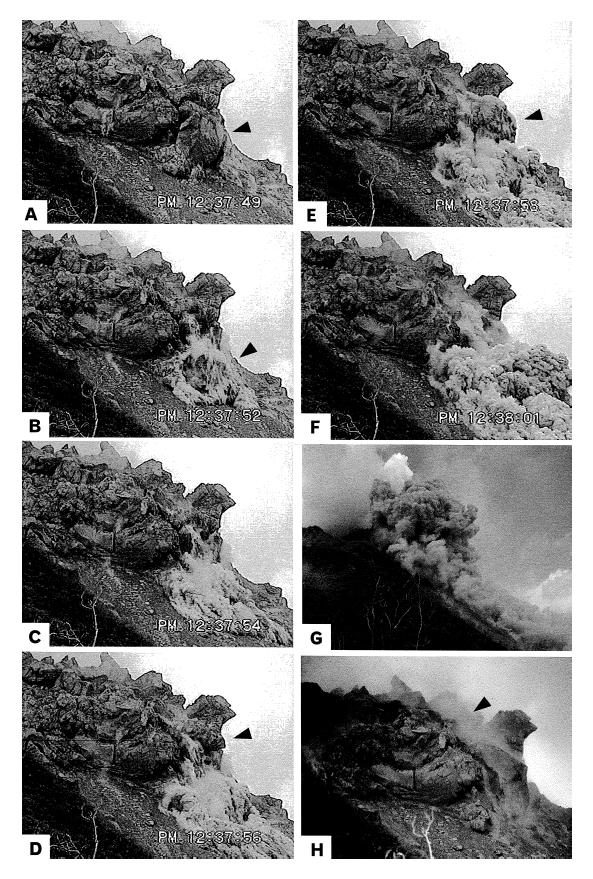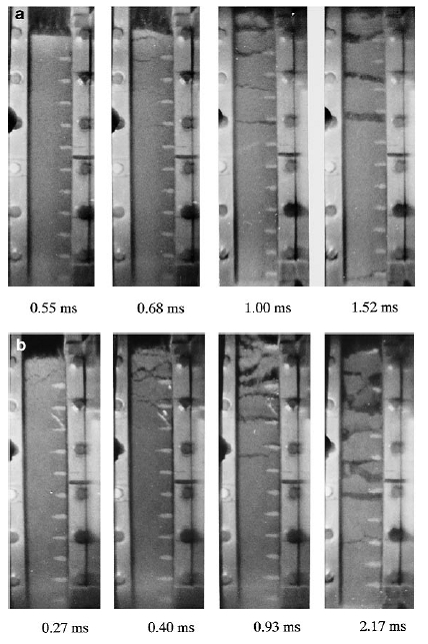18 June 2011
Favorite geology word: Autobrecciation (Accretionary Wedge #35)
Posted by Jessica Ball
Well, ash-flow tuff got taken pretty quickly, but I’m fairly certain no one will come up with my favorite geology term (or the particular meaning I’m going to talk about). That word is autobrecciation. I’m not talking about the autobrecciation that happens when the surface of a lava flow breaks up and gets incorporated into a lava flow, but the meaning used in several volcanology papers about rockfalls and lava dome collapses, and about which I wrote a term paper a couple of years ago.
To illustrate it visually, watch the first ten seconds or so of this video from the 1991 eruption of Mount Unzen, Japan:
See those blocks disintegrating as they collapse? That’s what I’m talking about when I refer to autobrecciation: volatile-rich, pressurized lava dome rocks fragmenting explosively in response to rapid decompression, which occurs at a critical pressure difference between the overpressurized rock and the surrounding environment (i.e., the point when the pressure overcomes the tensile strength of the rock). As you can see in the video, the rocks basically disintegrate into a lot of fine material (and probably some leftover rock chunks), which is the perfect recipe for a pyroclastic flow.
A more detailed progression of the autobrecciation process goes like this: (1) Crack propagation in dome lava or the fronts of lava flows occurs due to cooling or flow of the rock. (2) Small gas plumes are discharged from the cracks that become the point of detachment. (3) The rock mass becomes unstable and decreases in tensile strength, passing the brittle/ductile transition point and behaving brittlely rather than continuing to flow. (4) The block detaches from dome lobe or lava flow front, preceded by local explosions around the crack “head”. (5) The block fragments progressively from base to top. In many events, fragmentation is instantaneous, which would seem to preclude a contribution to the triggering mechanism by impact with slope. (6) Blocks continue to fragment as the pyroclastic flow moves downslope, providing much of the ash and gases that make up the overriding ash cloud.

Frames from video of the initiation of the block and ash flow from a lava lobe on the Unzen dome, February 25, 1992. The falling slab is ~20 m tall. Fragmentation is preceded by a puff of ash (marked by an arrow in image A), and the block autobrecciates progressively from the base to the top. From Sato et al., 2002.
The triggers for this process aren’t clear. Some people think that a simple rockfall – where a chunk of dome breaks off because of gravity pulling it downslope – initiates the fragmentation. Another possible trigger could be a small earthquake which causes the pressure situation inside the rock to become too unstable. The process itself has actually been pretty well modeled in the lab; it turns out that the fragmentation occurs in a wave, one “layer” of disrupted rock affecting the next, and so on inward until the whole rock is fragmented. (This also happens in a volcanic vent during an explosive eruption, where it’s usually referred to as explosive fragmentation.) During this process, ash is expelled from the cracks that form in the rock, which in autobrecciation produces all the fine material that forms a cloud around the fragmenting blocks.

Images of fragmenting plastiprin (low-temperature analogue for volcanic rocks) after release of a diaphragm separating the high and low pressure chambers of a "fragmentation bomb" (an experimental setup for fragmenting pressurized rock). From Alidibirov and Panov (1998).
Some of the earliest evidence for autobrecciation comes from observations of rockfalls, nuées ardentes and pyroclastic flows generated during the 1974 eruption of Fuego and 1991 eruption of Colima, where researchers were speculating on the mechanisms that could have produced particular pyroclastic deposits. Direct field observations of autobrecciation been made at Mount St. Helens in the US, Mount Unzen in Japan, and Soufriere Hills in the British West Indies. Researchers at Mount St. Helens first noted that relatively small rockfalls from an extruding dome lobe (filmed in April 1982) showed a large amount of fine debris forming as part of the lobe began to fail. Mellors et al. (1988) noted that the phenomenon occurred as the rocks were separating from the lobe, and the production rate of ash increased as the debris avalanche moved downslope. During field visits to the active dome, they also discovered that hot blocks from a young dome lobe would shatter when hit with a hammer, more thoroughly than the impact of the hammer could account for. (This sounds like an really fun and really dangerous thing to be doing to recent pyroclastic deposits, but we’ll give them the benefit of the doubt and assume that they were wearing appropriate safety gear.)
Autobrecciation is a pretty cool process – pretty much the disintegration of solid rock in the course of a few seconds. It’s also potentially a major player in turning rockfalls into pyroclastic flows, a serious hazard on volcanoes (especially ones with lava domes). Although we understand what happens to the rocks involved, we’re still not sure what triggers an autobrecciation event…which could be a thesis topic for another enterprising grad student, yes?
References and additional reading:
Alidibirov, M. and Panov, V., 1998. Magma fragmentation dynamics: experiments with analogue porous low-strength material. Bulletin of Volcanology, 59(7): 481-489. doi:10.1007/s004450050205
Calder, E.S., Luckett, R., Sparks, R.S.J. and Voight, B., 2002. Mechanisms of lava dome instability and generation of rockfalls and pyroclastic flows at Soufriere Hills Volcano, Montserrat. Geological Society, London, Memoirs, 21(1): 173-190. doi:10.1144/GSL.MEM.2002.021.01.08
Davies, D.K., Quearry, M.W. and Bonis, S.B., 1978. Glowing avalanches from 1974 eruption of Volcano Fuego, Guatemala. Geological Society of America Bulletin, 89(3): 369-384. doi:10.1130/0016-7606(1978)89<369:GAFTEO>2.0.CO;2
Martel, C., Dingwell, D.B., Spieler, O., Pichavant, M. and Wilke, M., 2001. Experimental fragmentation of crystal- and vesicle-bearing silicic melts. Bulletin of Volcanology, 63(6): 398-405. DOI: 10.1007/s004450100157
Mellors, R.A., Waitt, R.B. and Swanson, D.A., 1988. Generation of pyroclastic flows and surges by hot-rock avalanches from the dome of Mount St. Helens volcano, USA. Bulletin of Volcanology, 50(1): 14-25. doi:10.1007/BF01047505
Sato, H., Fujii, T. and Nakada, S., 1992. Crumbling of dacite dome lava and generation of pyroclastic flows at Unzen volcano. Nature, 360(6405): 664-666. doi:10.1038/360664a0


 Jessica Ball is a volcanologist at the U.S. Geological Survey, researching volcanic hydrothermal systems and stability, and doing science communication for the California Volcano Observatory. She previously worked at the Geological Society of America's Washington DC Policy Office, learning about the intersection of Earth science and legislative affairs. Her Mendenhall postdoc and PhD focused on how water affects the stability of volcanoes, and involved both field investigations and numerical modeling applications. Her blogging covers a range of topics, from her experiences in academic geosciences to science outreach and communication to her field and lab work in volcanology.
Jessica Ball is a volcanologist at the U.S. Geological Survey, researching volcanic hydrothermal systems and stability, and doing science communication for the California Volcano Observatory. She previously worked at the Geological Society of America's Washington DC Policy Office, learning about the intersection of Earth science and legislative affairs. Her Mendenhall postdoc and PhD focused on how water affects the stability of volcanoes, and involved both field investigations and numerical modeling applications. Her blogging covers a range of topics, from her experiences in academic geosciences to science outreach and communication to her field and lab work in volcanology.
What do you call breccias containing clasts that used to be automobiles?
🙂
Autobrecciation seems like one way of describing this. But, that seems inadequate because it has that something which makes it just ready to come apart. As the volcanologists said, there was more to its response to the rock hammer than expected. During Mt. St. Helens dome building, this looked like it increased throughout as it cooled, as if the rock was ready to spring apart, like forces within it wanting to expand into bits and pieces of ash, not just the gas, but the solid part. If not enough gas to explode, it breaks into pieces. Thus, autobrecciation is OK, Why not. A dome after losing external pressure and cooling, builds up forces throughout until it is ready to, sure “wants to” autobrecciate, and does. This is a scientific description word problem.
I like the term autobrecciation with your explanation. Scientific terminology is difficult to establish as a descriptive word for that activity. I have always wondered how it did that. Lava domes have always been of great human concern, because of their potential hazard. Japanese, for instance, probably have a fascinating historical record of volcanic events, and some involving those hot mounds of rock that push up in the mountains. It is wonderful that we have developed the science of Volcanology as we have today and can get involved using computers and internet. What I thought interesting is the gas content of these domes. After Mt. St. Helens had its major ash-gas eruption in 1980, it had two dome building episodes. The first one was rock of little gas content, and cooled down intact, but the second one had more gas content, with extruded spines that shattered as they cooled, and was thus more “lively” for study. Could it be that it is about time for another dome building episode with more gas content than the last and much greater danger from autobrecciation? I like this autobrecciation word. It would be nice to have a graph of domes showing-rock type – gas content – behavior. Thank you very much for your blog!
Autobrecciation Difficult to create an appropriate scientific term. This does not seem so bad for comparing domes of various gas content but getting into gas with finer material, it is more like autoclastic, and gets into pyroclastic. I started to think of what to do for a better term. I thought of “auto” and wondered if changed to “self” for selfbrecciation. This reminds me of physical forces acting within itself. However, “Self” also has anthropomorphic, like the human psyche, as metaphysical meaning, the “Self” in meditation, or Psychology as “self-destructive”. Maybe there is some sort of Greek or Roman word to use in place of “auto” or “self” to describe the behavior of domes. How domes crack-up is how I tend to think of it as a fast vernacular description and not involving complicated and careful decisions about a proper scientific term for this. The more gas there is in it and the more it cracks up gets worse and worse for safety and it is time for me to run. Thanks for the scientific word challenge.
What do you think about the process of autobrecciation in komatiite lavas? I’ve been working with archean komatiites and the amount of brecciated faciologies is too damn high (=p). I am wondering if these breccias are formed by igneous, hydrothermal or tectonic processes (the terrane is polydeformed), because they are not restricted to the top of the flows. The clasts are rounded to subangular (with cumulate textures preserved inside), and the matrix display fluidal textures, but vesicles are not present (so, there is no evidence that gas could have triggered the openning of the cracks…).
Interesting! Is it possible that you’re actually not looking at lavas? Some rheomorphic ignimbrites look an awful lot like lavas, and would lack vesicles. The trick is to look at phenocrysts – in lavas, something like <20% will be broken, as opposed to 30%+ in ignimbrites. Sometimes it's the only way to tell!